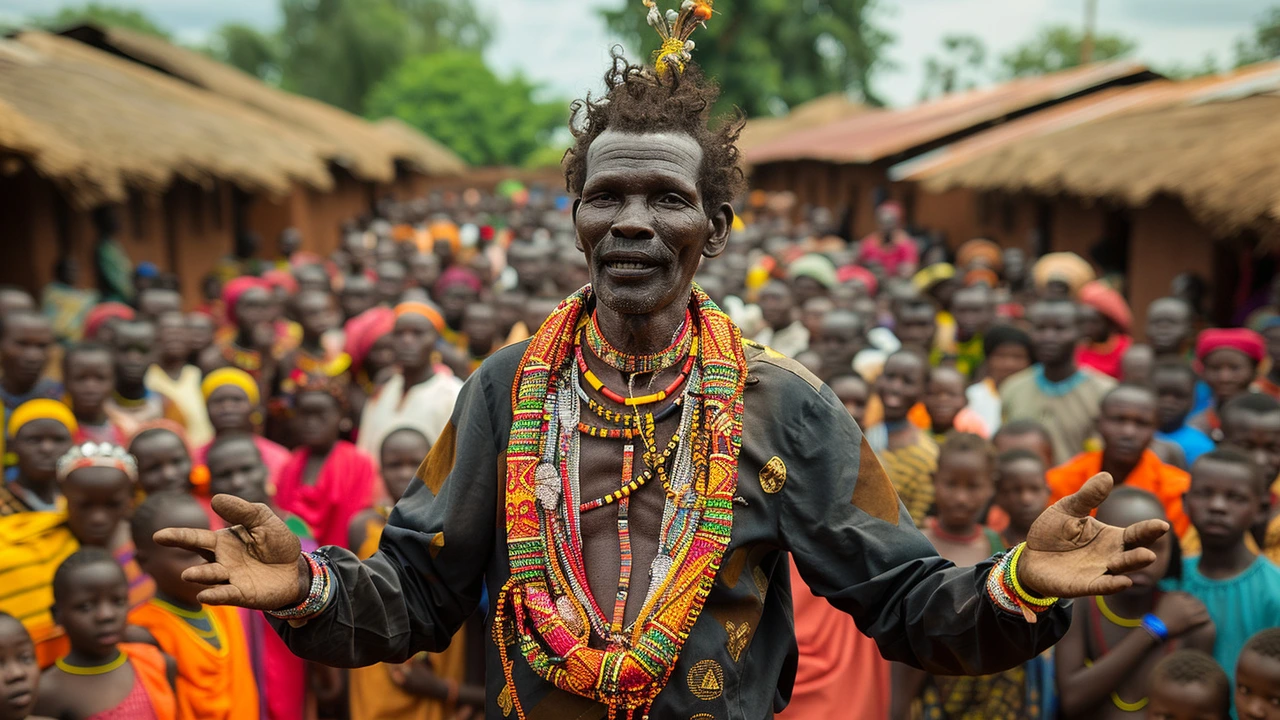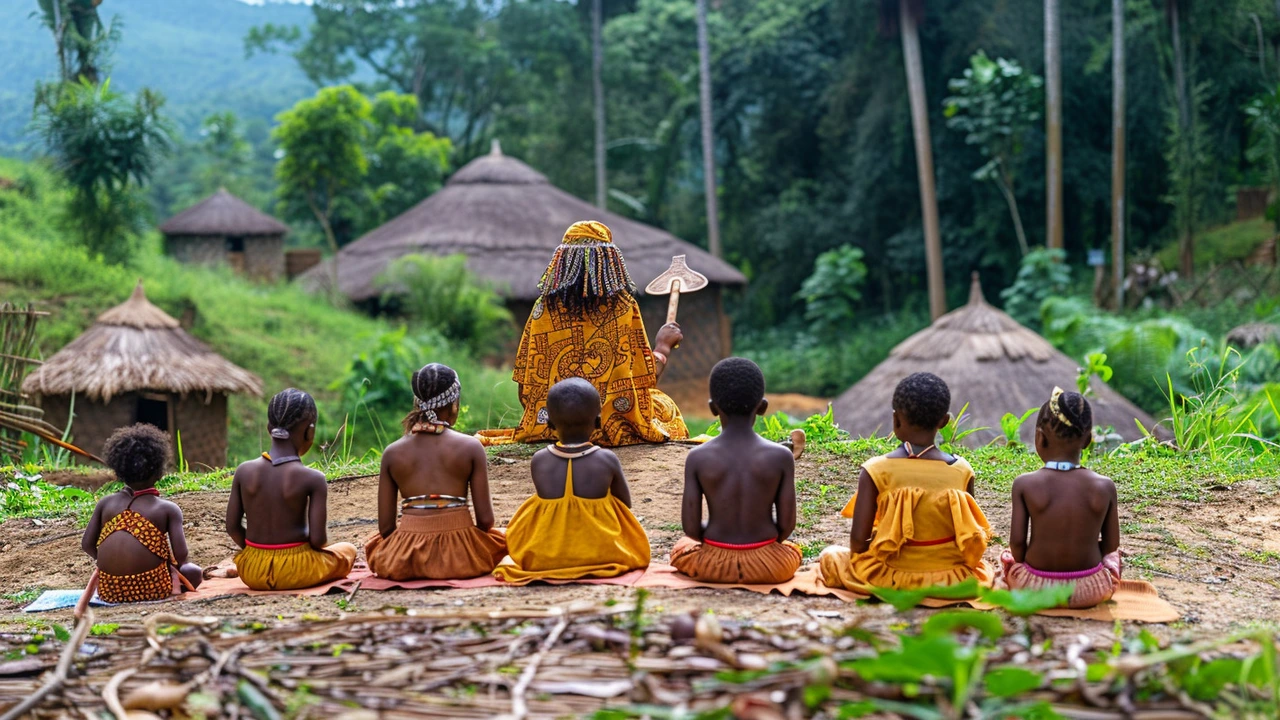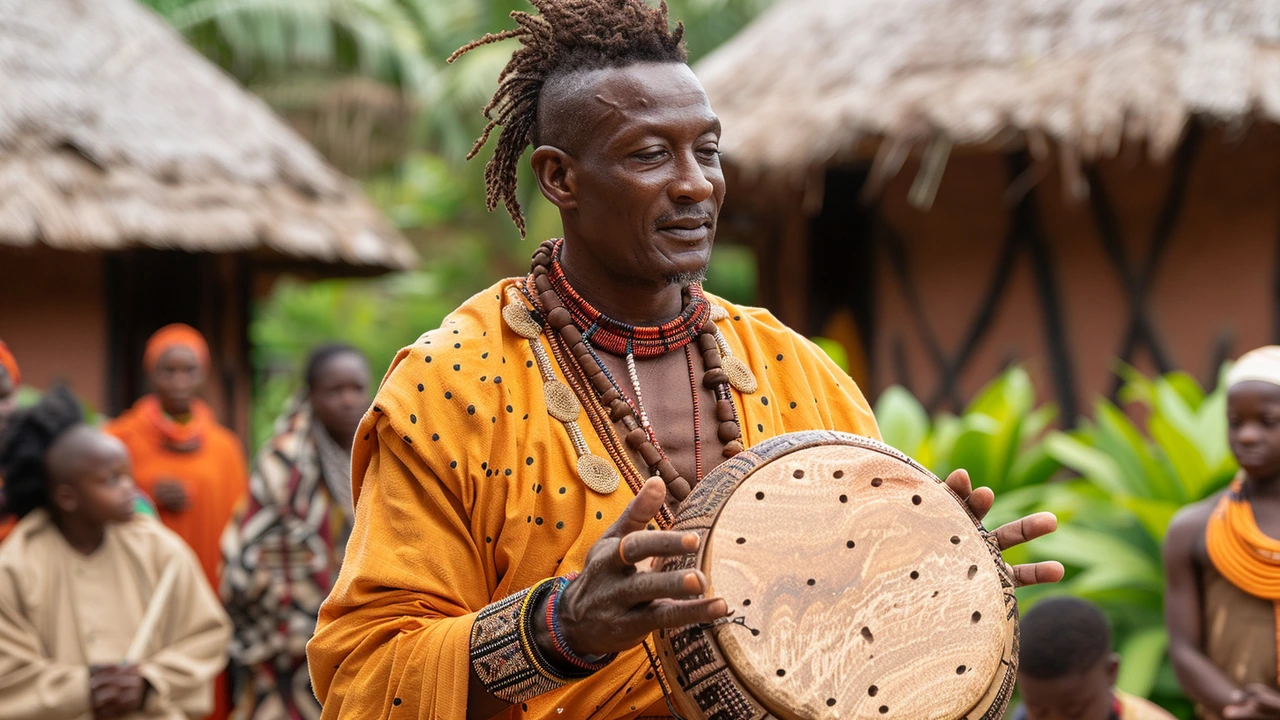Exploring the Diverse Uses of Rungu in African Cultures
 Jun, 6 2024
Jun, 6 2024
The rungu is a traditional wooden club used in various African societies. Despite its simple design, this versatile tool has managed to carve a niche across different aspects of cultural life. Its existence can be traced back centuries, skillfully crafted by artisans who imbued it with social significance.
Rungu’s journey from being a weapon of self-defense to a symbol of authority and respect is fascinating. Carried mostly by Maasai warriors, it signifies leadership, bravery, and a readiness to protect. Yet, the rungu transcends its martial origins and finds a place in ceremonies and daily chores.
In today's globalized world, the rungu is no longer confined to African societies alone. Collectors and anthropologists globally are intrigued by its unique history and multifaceted uses. This article takes you through this remarkable artifact's journey, showcasing its enduring relevance and cultural richness.
- Historical Background of the Rungu
- Rungu as a Symbol of Authority
- Practical Uses in Daily Life
- Ceremonial and Ritualistic Importance
- Modern-Day Relevance
Historical Background of the Rungu
The rungu holds a significant place in the history of African societies, especially among the Maasai people of East Africa. Its origins can be traced back hundreds of years, evolving as a crucial tool for self-defense and even as a hunting weapon. Crafted from sturdy wood, usually from the shrub Grewia bicolor, the rungu features a handle and a bulbous head, which makes it an effective tool in hand-to-hand combat and hunting.
Besides its practical use in combat and hunting, the rungu has become a potent symbol of authority and status within various African communities. Traditionally, only certain members of society, such as tribal leaders and warriors, were allowed to carry it. This wasn't just about having a weapon; possessing a rungu was a statement of power, responsibility, and bravery. The woodwork is often detailed with carvings or ornamentations, making each rungu unique and personalized to its owner.
Historical accounts indicate that the rungu might have been used in ceremonial practices. It played a pivotal role in rituals and traditional ceremonies, signifying transitions such as manhood initiation rites. In some tribes, it was also used in blessings and to ward off evil spirits, showing its spiritual significance besides its physical utility. Anthropologists believe that these ceremonies reinforced social structures and cultural norms, with the rungu being a tangible manifestation of these values.
The narrative of the rungu doesn't end with history. It mirrors the shifts in African societies through centuries. The tool has adapted and even spread beyond its regions of origin. Traders and explorers often took rungu back to their countries as souvenirs, further embedding its place in the global historical tapestry. The endurance of the rungu in African culture demonstrates its versatility and deeper symbolic meanings that have transcended time and geography.
The rungu was not only a tool but a storyteller, reflecting the survival, bravery, and traditions of the people who wielded it. Today, collectors and historians alike are fascinated by its intricate design and the stories woven into its wood. This artifact stands as a testament to the ingenuity and spirit of the African communities that have preserved it through ages. As a British explorer, Sir Elton Gregory, once marveled, "The rungu, in its simplicity, carries the weight of centuries of heritage and bravery."
Rungu as a Symbol of Authority
The rungu’s journey to becoming a symbol of authority in African societies is both fascinating and significant. Among the Maasai, one of the most well-known tribes in East Africa, the rungu transcends its role as a weapon. It has come to embody leadership, strength, and responsibility. Traditionally, a Maasai warrior, or Morani, would carry a rungu not just as a tool for self-defense but as an emblem of his social and warrior status. To carry a rungu was to carry the weight of leadership and courage.
The significance of the rungu extends beyond the Maasai tribe. It is also featured prominently in the practices of the Samburu and Kikuyu tribes, among others. In these communities, elders and chiefs often wield runngus as markers of their authority. This tradition is rooted in centuries of cultural heritage, where the rungu's very presence commands respect and conveys a message of unwavering strength. It is a visual representation of the responsibility carried by those in power.
It's interesting to note that during ceremonies and council meetings, the rungu takes on a ceremonial role. Chiefs and elders use it while making important decisions or addressing the community. The rungu in these contexts is not just held but also displayed prominently, reinforcing the authority of the speaker. This practice underscores the deeply ingrained respect for tradition and hierarchy in these societies, where physical symbols like the rungu play a crucial role in maintaining order and decorum.
In addition, the design and ornamentation of a rungu can also signify the rank and accomplishments of its bearer. Elaborate engravings and special carvings often depict the feats and lineage of the owner, making each rungu unique. This customization adds a personal and historical dimension to the artifact, embedding it further into the cultural fabric of the society. As such, a rungu is much more than a piece of wood; it is a crafted narrative of honor and legacy.
According to **John Ole Moipei**, a respected Maasai elder,
"The rungu is not just a weapon. It is the voice of the leader, a reminder of our past, and a pledge to our future. When you see a man with a rungu, you see the protector and the guide of our people."This statement encapsulates the multifaceted role of the rungu as a token of respect and a guardian of traditions.
Over time, the symbolic role of the rungu has even transcended African borders. In global cultures, symbols similar to the rungu have emerged, illustrating how leadership and authority often need tangible representation. Despite modern influences, the traditional significance of the rungu remains strong, with many African leaders continuing to honor this powerful emblem. Interestingly, in some modern African societies, runngus are still gifted to notable figures and dignitaries as a sign of great respect and recognition.

Practical Uses in Daily Life
In African societies, the versatile rungu goes beyond its traditional role as a weapon. It seamlessly integrates into the daily life of many communities. Imagine a tool that not only offers protection but also serves as a multi-functional instrument in everyday activities. That’s exactly what the rungu accomplishes in African villages.
One of the most common practical uses of the rungu is in herding livestock. Due to its sturdy build, the rungu comes in handy for guiding and protecting herds of cattle, goats, or sheep. It can be used to gently nudge animals or to ward off potential threats, ensuring the safety of both the herder and the livestock.
A notable fact is that in some communities, the rungu is employed in agricultural activities. The tool can help clear dense vegetation or dig up roots while planting. Its durable wooden structure provides an efficient means to tackle various farm chores, proving to be indispensable during the planting seasons.
The domestic realm also sees the utility of the rungu. Children may play simple throwing games with it, developing their hand-eye coordination and physical strength. Even in contexts where a stick or pole might be used to secure the entrance of a hut or a grain storage, the rungu steps up to the task, showcasing its practicality.
“The rungu is not just a symbol of strength but a daily companion for many of us, whether in the fields or at home,” says Naisiae, a Maasai elder from Kenya.
Given its durability, the rungu is also handy during community gatherings or events. When communal cooking takes place, it helps in managing open fires and moving heavy cooking pots. Its multifunctionality stands out particularly during these group activities, cementing its place not just as a weapon but as an essential household tool.
The construction of the rungu itself contributes to its myriad uses. Traditionally made from durable hardwoods, it is often treated to withstand varying weather conditions. The design varies depending on the intended practical use, with some being more robust for harder tasks and others more lightweight for ease of carrying.
Some intriguing uses of the rungu reflect its adaptability. In certain regions, it's part of traditional Healer’s kits and used in therapeutic rituals to ward off negative energies. This highlights how the rungu evolves with the community’s needs, making it a significant cultural tool that adapts to various practical applications.
Ceremonial and Ritualistic Importance
In African societies, the rungu is not just a weapon but a crucial part of many cultural rituals and ceremonies. It carries a weight of symbolism that varies from one ethnic group to another. In Maasai culture, warriors hold a special ceremony called 'Eunoto,' marking their transition into elderhood. During this ceremonial rite, the rungu plays a central role, passed from the older generation to younger warriors, symbolizing the transfer of wisdom and responsibility.
The Kikuyu community, on the other hand, uses the rungu in bridal ceremonies. When a bride enters her new home, she carries a rungu decorated with intricate beads and carvings. This decorated rungu is not only a symbol of beauty and art but also stands for protection and strength, embodying the virtues expected from the new member of the family.
The rungu also holds spiritual significance. Many African tribes believe it possesses protective powers against malevolent spirits. During rituals intended to ward off evil or seek blessings, the rungu often features prominently. For instance, during rain-making ceremonies, spiritual leaders or medicine men use rungus to invoke weather gods, believing that the force and intention behind the stroke will manifest in abundant rains.
In contemporary times, the ceremonial utilization of the rungu has expanded its influence beyond tribal boundaries. Events like commemorations of cultural heritage and festivals celebrating African traditions often highlight the rungu. It is not uncommon to see performers and cultural ambassadors wielding the rungu in choreographed dances, thereby reviving ancient practices while keeping the younger generation engaged and connected to their roots.
While the rungu serves practical purposes in daily tasks, its profound ceremonial importance cannot be understated. As anthropologist John S. Mbiti noted,
“The use of objects like the rungu in ceremonies helps bind communities, creating an unbroken thread that links the past with the future.”The intricate carvings and personalized touches often seen on ceremonial rungus also showcase the artistic skills of the craftsperson, preserving traditional art forms that might otherwise fade away.
As African societies evolve, the rungu continues to serve as a bridge between the old and the new. It embodies the spirit, resilience, and cultural richness of the communities that hold it dear. Through its role in ceremonies and rituals, the rungu ensures that cultural memories and practices are not forgotten but celebrated and cherished, echoing through generations.

Modern-Day Relevance
The rungu, though ancient in origin, has smoothly transitioned into modern times, retaining its cultural and practical significance. In many African communities, it continues to serve as a proud symbol of heritage and identity. The rungu is not just an artifact for museum displays; it plays active roles in contemporary life, often surprising outsiders with its diverse applications.
In Kenya, especially among the Maasai, the rungu remains a cherished emblem of warrior ethos. Today, it is used in official ceremonies where it symbolizes leadership and respect. When Maasai leaders or elders address the community, holding a rungu, their words carry added weight and authority. The rungu's presence in modern rites of passage, such as coming-of-age ceremonies, underscores its enduring relevance.
During celebratory events like weddings and community gatherings, the rungu also plays a part. It is often seen in traditional dances where its rhythmic movements add to the vibrancy of the performance. Such integrations into cultural festivities highlight the rungu's versatility beyond its historical roles of defense and authority.
A striking fact is how the rungu has transcended its traditional boundaries to become an item of intrigue worldwide. Collectors and enthusiasts are drawn to its unique history and craftsmanship. Anthropology museums now feature the rungu in their exhibits, providing visitors a tangible connection to African heritage. This global interest has not only increased the rungu’s visibility but also encouraged local artisans, creating income opportunities and helping preserve traditional crafting techniques.
The influence of the rungu has even reached the sphere of fashion and aesthetics. Contemporary African fashion designers incorporate rungu motifs into their designs, making it an element of modern style statements. These designs often blend traditional and modern aesthetics, celebrating the rungu's cultural significance while catering to trendy tastes.
For those interested in sustainable practices, the rungu offers interesting insights. Its crafting process emphasizes the use of locally sourced, sustainable materials, reflecting a deep ecological consciousness. This aligns perfectly with the growing global emphasis on sustainability and responsible consumption. More people are turning towards artifacts like the rungu as they seek authentic, eco-friendly products.
On the international stage, the rungu has also made appearances in diplomatic gifts and cultural exchanges. Its simplicity and symbolic depth make it a profound gift, signifying respect and alliance. This practice highlights how a humble wooden club can convey powerful messages across cultures, bridging gaps and fostering mutual appreciation.
Interestingly, the rungu has found its place in the world of art and storytelling. Artists and filmmakers use its distinctive silhouette to add cultural depth to their work. In storytelling, the rungu often features in narratives of courage, leadership, and tradition. This reflects how the rungu’s essence continues to inspire contemporary creators, maintaining its relevance in new and innovative ways.
"The rungu is more than an artifact; it is a testament to the enduring spirit of African cultures and their ability to adapt and thrive," says Dr. Njeri Kinyanjui, a cultural anthropologist.
